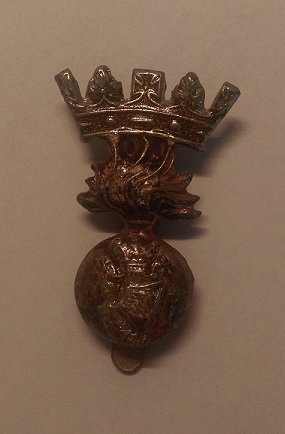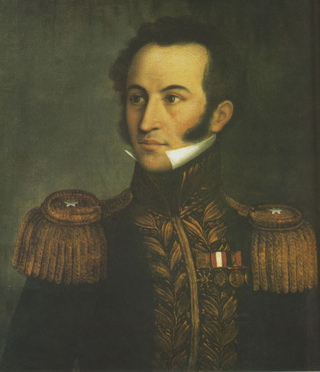Related Research Articles

The King's Royal Rifle Corps was an infantry rifle regiment of the British Army that was originally raised in British North America as the Royal American Regiment during the phase of the Seven Years' War in North America known in the United States as 'The French and Indian War.' Subsequently numbered the 60th Regiment of Foot, the regiment served for more than 200 years throughout the British Empire. In 1958, the regiment joined the Oxfordshire and Buckinghamshire Light Infantry and the Rifle Brigade in the Green Jackets Brigade and in 1966 the three regiments were formally amalgamated to become the Royal Green Jackets. The KRRC became the 2nd Battalion, Royal Green Jackets. On the disbandment of the 1st Battalion, Royal Green Jackets in 1992, the RGJ's KRRC battalion was redesignated as the 1st Battalion, Royal Green Jackets, eventually becoming 2nd Battalion, The Rifles in 2007.

The Battle of Boyacá (1819), also known as the Battle of Boyacá Bridge was a decisive victory by a combined army of Venezuelan and New Granadan troops along with a British Legion led by General Simon Bolivar over the III Division of the Spanish Expeditionary Army of Costa Firme commanded by Spanish Colonel José Barreiro. This victory ensured the success of Bolívar's campaign to liberate New Granada. The battle of Boyaca is considered the beginning of the independence of the north of South America, and is considered important because it led to the victories of the battle of Carabobo in Venezuela, Pichincha in Ecuador, and Junín and Ayacucho in Peru. New Granada acquired its definitive independence from the Spanish Monarchy, although fighting with royalist forces would continue for years.

The Canadian Grenadier Guards (CGG) is a reserve infantry regiment in the 34 Canadian Brigade Group, 2nd Canadian Division, of the Canadian Army. The regiment is the oldest and second-most-senior infantry regiment in the Primary Reserve of the Canadian Army. Located in Montreal, its main role is the provision of combat-ready light infantry troops in support of Canadian regular infantry. It is a Household Foot Guard regiment and also provides soldiers for public ceremonial duties, performing similar ceremonial duties as the Guards regiments of the British Army. This primarily entails mounting the guard at Government House, the King's and Governor General's residence, and performing the "Changing the Guard" ceremony on Parliament Hill in Ottawa, a task it shares with Canada's senior Household Foot Guard regiment, the Governor General's Foot Guards of Ottawa. The Canadian Grenadier Guards is an allied regiment to the British Grenadier Guards.

The Rifle Brigade (The Prince Consort's Own) was an infantry rifle regiment of the British Army formed in January 1800 as the "Experimental Corps of Riflemen" to provide sharpshooters, scouts, and skirmishers. They were soon renamed the "Rifle Corps". In January 1803, they became an established regular regiment and were titled the 95th Regiment of Foot (Rifles). In 1816, at the end of the Napoleonic Wars, they were again renamed, this time as the "Rifle Brigade".
The Rifles is an infantry regiment of the British Army. Formed in 2007, it consists of four Regular battalions and three Reserve battalions. Each Regular battalion was formerly an individual battalion of one of the two large regiments of the Light Division. Since formation, the regiment has been involved in the later stages of the Iraq War and in the War in Afghanistan.

The Royal Irish Rifles was an infantry rifle regiment of the British Army, first created in 1881 by the amalgamation of the 83rd Regiment of Foot and the 86th Regiment of Foot. The regiment saw service in the Second Boer War, the First World War, the Second World War, and the Korean War.
The Light Division is a light infantry division of the British Army. It was reformed in 2022, as part of Future Soldier reforms.

The Cameronians (Scottish Rifles) was a rifle regiment of the British Army, the only regiment of rifles amongst the Scottish regiments of infantry. It was formed in 1881 under the Childers Reforms by the amalgamation of the 26th Cameronian Regiment and the 90th Perthshire Light Infantry. In 1968, when reductions were required, the regiment chose to be disbanded rather than amalgamated with another regiment, one of only two infantry regiments in the British Army to do so, with the other being the York and Lancaster Regiment. It can trace its roots to that of the Cameronians, later the 26th of Foot, who were raised in 1689. The 1881 amalgamation coincided with the Cameronian's selection to become the new Scottish Rifles.

The 11th Brigade is a brigade of the British Army which is transitioning to the tactical recce-strike role. The brigade was formerly the 11th Security Force Assistance Brigade, providing training and guidance for foreign militaries.

The 29th Infantry Brigade was an infantry brigade unit of the British Army. It was originally raised in 1914 and saw service during the First and Second World Wars and the Korean War.
The Irish military diaspora refers to the many people of either Irish birth or extraction who have served in overseas military forces, regardless of rank, duration of service, or success.

The Royal Irish Fusiliers (Princess Victoria's) was an Irish line infantry (later changed to light infantry) regiment of the British Army, formed by the amalgamation of the 87th (Prince of Wales's Irish) Regiment of Foot and the 89th (Princess Victoria's) Regiment of Foot in 1881. The regiment's first title in 1881 was Princess Victoria's (Royal Irish Fusiliers), changed in 1920 to the Royal Irish Fusiliers (Princess Victoria's). Between the time of its formation and Irish independence, it was one of eight Irish regiments.
The 234th Infantry Brigade was an infantry brigade of the British Army, raised during the First World War, and was later reformed during the Second World War.

The British Legion or British Legions were foreign volunteer units which fought under Simón Bolívar against Spain for the independence of Colombia, Venezuela, and Ecuador, and under José de San Martín for the independence of Peru, in the Spanish American wars of independence. Venezuelans generally called them the Albion Legion. They were composed of over seven thousand volunteers, mainly Napoleonic War veterans from Great Britain and Ireland, as well as some German veterans and some locals recruited after arriving in South America. Volunteers in the British Legion were motivated by a combination of both genuine political conviction and mercenary motives.
The 168th Brigade was an infantry brigade formation of the British Army that saw service during both the First and the Second World Wars. Throughout its existence, serving under many different titles and designations, the brigade was an integral part of the 56th (London) Infantry Division. It served on the Western Front during First World War and in the Italian Campaign during the Second World War. It was finally disbanded in the 1960s.

James Rooke (1770–1819) also known as Jaime Rooke or Jaime Rook was a British career soldier who fought in the Napoleonic wars and in the Venezuelan and Colombian wars of Independence.
The 169th Brigade was an infantry brigade of the British Army that saw active service in both the First and the Second World Wars. Throughout its existence the brigade, serving under numerous many different titles and designations, was an integral part of the 56th (London) Infantry Division. It served on the Western Front in the First World War, and in the North African and Italian campaigns during the Second World War.

Arthur Sandes was the commanding officer of the Rifle Battalion of the British Legions in the Spanish American wars of independence. Sandes came to Venezuela to join the Regiment of Rifles led by Colonel Frederick Campbell taking part in the "expedition of the Five Colonels".
The 96th Regiment of Foot was the fourth light infantry regiment of the British Army to bear this name. It was originally created from the 2nd Battalion of the 52nd Regiment of Foot in 1803 at the start of the Napoleonic Wars. Initially a single battalion regiment, a second battalion was raised in 1804. The Regiment was based mainly in the Caribbean and on Jersey and renumbered as the 95th Regiment of Foot. Following the defeat of Napoleon, the British army was reduced in size, and the regiment was disbanded in 1818.

The London Guards is a formation within the British Army comprising the reserve companies of the Grenadier, Coldstream, Scots and Irish Guards. On formation these companies drew their personnel from the London Regiment and it traces its history back to the formation of that regiment in 1908 when 26 separate Volunteer Force battalions were brought together. The London Guards is not a regiment, the companies wear the uniform, and follow the traditions, of their foot guards regiment.
References
- Arthur Sandes. Dictionary of Irish Latin American Biography [usurped]